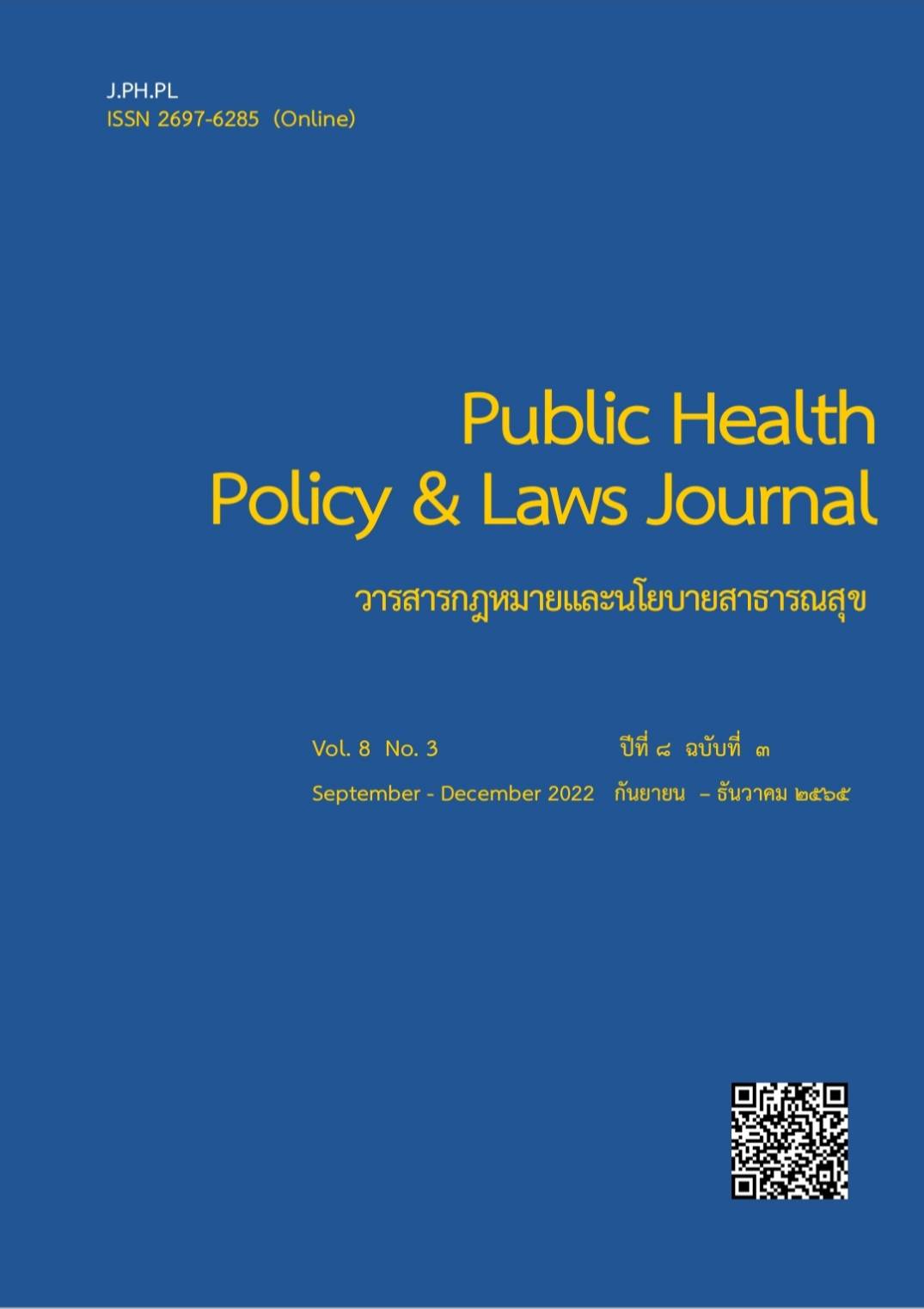The factor that affects the diagnosis of an incorrectly incised wound in the clinical forensic division, Surin hospital
Keywords:
open wound, incised wound, type of wound, forensic, clinical forensicAbstract
Diagnosis type of open wounds such as a laceration or incised wound can refer to the object that made the wound. It's essential in the trial. To determine the factor that affects the diagnosis of an incorrectly incised wound. The research with a retrospective cohort design was conducted by medical records review of the patients who were physical assault by a sharp object and was incised wounds at Surin Hospital from July 2017 to February 2022. Used multivariable logistic regression to investigate the significant factor that affects the diagnosis of an incorrectly incised wound.
A total of 254 patients were physical assault by a sharp object and were incised wounds. 179 cases (70.5%) were incorrectly diagnosed as laceration wounds. The mean age of victims was 34.5 (+ 14.17) years and mostly male (89%). The factor that significant effect incorrectly incised wounds were other types of the wound found (OR 1.88, 95%CI 1.06-3.31), the wound aged more than 1 hr. (OR 1.87, 95%CI 1.06-3.29). Especially incorrectly diagnosed incised wound from the first hospital (OR 12.22, 95%CI 2.04-73.19) and the wound that was sutured (OR 11.82, 95%CI 1.56-89.75) increases the risk of incorrectly diagnosed incised wounds significantly. Patient history about the object used is important for wound examination. The especially sutured wound should be aware that it is an incised wound, not a laceration.
References
ดวงกมล ปิ่นเฉลียว. (2563). แนวทางในการดูแลผู้ป่วยคดีสำหรับพยาบาล (THE GUIDELINE OF FORENSIC PATIENTS CARE FOR NURSES). Journal of The Police Nurses, 12 (1), 244-250. https://he01.tci-thaijo.org/index.php/policenurse/article/view/240087/165592นิติกร โปริสวาณิชย์. (2557). คู่มือการปฏิบัติงานนิติเวช (สำหรับแพทย์และบุคลากรทางการแพทย์) กระทรวงสาธารณสุข. https://phdb.moph.go.th/main/index/downloadlist/53/7
ธัญญศักดิ์ เอกเวชวิท, ทศนัย พิพัฒน์โชติธรรม (2557). Blunt force injury. ใน วชิระ เพ็งจันทร์ และธงชัย เลิศวิไลรัตนพงศ์ (บ.ก.), คู่มือการปฏิบัติงานนิติเวช (สำหรับแพทย์และบุคลากรทางการแพทย์) กระทรวงสาธารณสุข. (น.96-100). กรุงเทพมหานคร : สำนักงานปลัดกระทรวงสาธารณสุข.
เปรมฤดี ทวีคง. (2561). การตรวจบาดแผล. ใน อนิรุธ วรวาท, กันต์ ทองแถม ณ อยุธยา, วิรัชญา ลิ้มกิติศุภสิน, ณัฐพงษ์ ตุลาพันธุ์ และกนกนาค หงสกุล (บ.ก.), คู่มือการตรวจผู้ป่วยคดี ปีงบประมาณ 2561. (น.1-4). กรุงเทพมหานคร : สำนักงานปลัดกระทรวงสาธารณสุข.
วิจารณ์ วชิรวงศากร และ ศักดิ์สิทธิ์ บุญลักษณ์. (2557). การชันสูตรบาดแผลทางนิติเวชศาสตร์. ใน วชิระ เพ็งจันทร์ และธงชัย เลิศวิไลรัตนพงศ์ (บ.ก.), คู่มือการปฏิบัติงานนิติเวช (สำหรับแพทย์และบุคลากรทางการแพทย์) กระทรวงสาธารณสุข. (น.91-94). กรุงเทพมหานคร : สำนักงานปลัดกระทรวงสาธารณสุข.
สุธิดา บูชิตรัตนคุณ, ศักดา สถิรเรืองชัย (2557). Sharp force injury. ใน วชิระ เพ็งจันทร์ ธงชัย เลิศวิไลรัตนพงศ์ (บ.ก.), คู่มือการปฏิบัติงานนิติเวช (สำหรับแพทย์และบุคลากรทางการแพทย์) กระทรวงสาธารณสุข. (น.101-107). กรุงเทพมหานคร : สำนักงานปลัดกระทรวงสาธารณสุข.
อภิชัย แผลงศร. (ม.ม.ป.). นิติเวชคลินิก (Clinical forensic medicine). http://med.swu.ac.th/forensic/images/AP_CFM(new)_1-60.pdf
Akshat V, Anand M, Ritesh G. M, Tanuj K, Prateek R (2010). A retrospective review of homicides in Mangalore, South India. Journal of Forensic and Legal Medicine, 17(6), 312-315. doi:10.1016/j.jflm.2010.04.012
Archana C. , Srijana K. , Samjhana G. , Harihar W. (2020). Patterns and Severity of Injuries in Patients Following Physical Assault– A Medicolegal Aspects. Eastern Green Neurosurgery, 2(2), 16-20. doi : 10.3126/egn.v2i2.29238
Basappa SH , Harish S, Girish C.Y. P, Praveen S. Jayanth S.H.3 (2012). Study of defense injuries in homicidal deaths – An autopsy study. Journal of Forensic and Legal Medicine, 19(4), 207-210. doi: 10.1016/j.jflm.2011.12.022
Carr D.J, Godhania K, Mahoney P.F (2018). Edged weapons awareness. International Journal of Legal Medicine, 133(4), 1217-1224. doi : 10.1007/s00414-018-1966-6
Christine A G, Fiona M, David I. C, Alex D M. (2019). Assault–related sharp force injury among adults in Scotland 2001–2013: Incidence, socio-demographic determinants and relationship to violence reduction measures. Aggression and Violent Behavior, 46(1), 190-196. doi: 10.1016/j.avb.2018.10.002
Christophe B.A. , Christophe F.B. , Michel D.A , Geoffroy L.G. (2010). Homicidal and suicidal sharp force fatalities: Autopsy parameters in relation to the manner of death. Forensic Science International, 198(1-3), 150-154. doi:10.1016/j.forsciint.2010.02.017.
Crane J (2009). Injury. In Maclay W.D.S. (Ed.), Clinical Forensic Medicine 3rd edition.
(p. 99-113). Newyork : Cambridge University Press.
Eni U. E, Na’aya H. U, Musa A. M, Lawan M. A , Chinda J. Y. (2009). An Audit of Non-Fatal Assault Injuries Treated In Federal Medical Center (FMC), Nguru, North East Nigeria. Nigerian Journal of Medicine, 18(2), 168-171. doi : 10.4314/njm.v18i2.45057
Manoj K. M, Mohan K.2 , Arun M.3 , Vikram P.4 (2005). Victims of homicidal deaths – an analysis of variables. Journal of Clinical Forensic Medicine, 12(6), 302-304. doi:10.1016/j.jcfm.2005.03.007.
Karlsson T. (1998). Homicidal and suicidal sharp force fatalities in Stockholm, Sweden. Orientation of entrance wounds in stabs gives information in the classification. Forensic Science International, 93(1), 21-32. doi : 10.1016/s0379-0738(98)00025-5
Payne J.James & J. Hinchliffe. (2011). Injury Assessment, Documentation, and Interpretation. In Magaret M (Ed.), Clinical Forensic Medicine A Physician’s Guide. 3rd edition.
(p. 146-147). London : Springer New York Dordrecht Heidelberg.
Payne J.James. (2016). Injury, Fatal and Nonfatal : Sharp and Cutting-Edge Wounds. Retrieved 15 May 2022, from/ https://asomef.org.co/wp-content/uploads/2020/04/Injury-Fatal-and-Nonfatal-Sharp-and-Cutting-Edge-Wounds.pdf
Saurabh C. & Biswajit S. (2013). Pattern of defense injuries among homicidal victims. Egyptian Journal of Forensic Sciences, 3(3), 81-84. doi : 10.1016/j.ejfs.2012.11.002
Sharma B. R. (2003). Clinical forensic medicine – management of crime victims from trauma to trial. Journal of Clinical Forensic Medicine, 10(4), 267-273. doi : 10.1016/j.jcfm.2003.09.003
Subba S. , Binu V. , Ritesh G.M. , Virendra K.4 (2010). Physical assault related injuries in Western Nepal – A hospital based retrospective study. Journal of Forensic and Legal Medicine, 17(4), 203-208. doi : 10.1016/j.jflm.2010.02.001
Ursus-Nikolaus R & Martin W (2004). Tissue Repair. In U.N. Riede (Ed.), Color Atlas of Pathology. (p.310-312). Stuttgart : Druckhaus Go¨tz, Ludwigsburg.
World Health Organization. (2022). Estimates of number of homicides. https://www.who.int/data/gho/data/indicators/indicator-details/GHO/ghe-estimates-of-number-of-homicides.
Downloads
Published
How to Cite
Issue
Section
License
Disclaimer and Copyright Notice
The content and information presented in articles published in the Journal of Law and Public Health Policy represent the opinions and sole responsibility of the respective authors. The editorial board does not necessarily agree with or assume any responsibility for the views expressed.
All articles, data, content, images, and other materials published in the Journal of Law and Public Health Policy are the intellectual property of the journal. Any individual or organization wishing to reproduce, distribute, or otherwise use the entirety or any part of such materials must provide proper citation.





